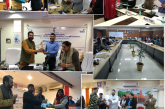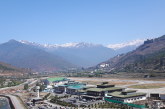With more than 21 percent of the world’s population, the South Asia region (comprising of Afghanistan, Bangladesh, Bhutan, India, the Maldives, Nepal, Pakistan, and Sri Lank) has access to just over 8 percent of global water resources. Average water availability per capita across the region has declined by 70 percent since the 1950s, and continues to decrease. Increasing population intensified agricultural practices and irrigation; multiplying energy demand from greater industrial activity and economic growth; urbanization; complex environmental consequences of climate change, deteriorating river ecology, and deteriorating water quality in the regions’ surface and groundwater resources etc., continue to unfold new challenges for the region’s already scarce water resources. South Asia’s water problems can be significantly extenuated through improved water governance of its major transboundary rivers: the Indus, Ganges, and Brahmaputra, which straddle international boundaries and support the lives of about one billion people. The objective of effective regional cooperation in managing Transboundary Rivers in the region will only be achieved when countries work together collaboratively.
Management of water resources of trans-boundary rivers in South Asia is governed by the mechanism of bilateral treaties which are subject to domestic pressures and regional geopolitical compulsions. Transboundary river basin management is of crucial concern for almost all human beings as about 40 per cent of global population resides in river basins that are shared by countries. These transboundary river basins encompass almost half of the Earth’s land surface and provide over 60 per cent of global freshwater flow. The avowed objective of managing transboundary river basins is to bring the people out of poverty, securing their livelihoods and support development efforts in a sustainable manner.
Critical Water Challenges in South Asia
Recurring incidents of water and climate-induced disasters like torrential rains, flash floods, landslides, and cloudbursts have put further strain on already scarce water resources of South Asia. Besides, water security in South Asia is under threat from many sources: population growth, urbanization, increasing water pollution, the over-abstraction of groundwater, water-related disasters, and climate change. Current planning and management have proven insufficient to address the challenges of meeting South Asia’s diverse needs for water. The adverse impact of climate change transcends geographical boundaries and as such any climate-induced or water-induced disaster in border areas of South Asia is prone to cause damage to the geographic contiguous areas of the neighbouring country and vice-versa. The water and climate change induced disasters wreak havoc in terms of loss of human and cattle lives, damage to property and loss of livelihoods of the people. This eventually retards the pace of development and entails potentials of jeopardizing security of the nation as well. Water is the main driver of economic growth and sustainable development.
Ganga River Basin and Brahmputra River Basin are two major transboundary river basins in the Himalayan region of South Asia. The Ganga River Basin involves Nepal, India and Bangladesh; whereas Brahmputra River basin involves China, India and Bangladesh. The transboundary river basin management in the Himalayan region of South Asia is faced with particular challenges pertaining to different national interests, power disparities between riparian states, differences in national institutional capacity, limited information exchange and lack of sufficient basin scale knowledge and institutional capacity to make decisions.
Structural features of political geography in the Ganga River Basin pose some impediments to basin-wide management of this region. India’s upper riparian position gives it advantages vis-à-vis Bangladesh. Bangladesh suffers one of the least favourable river dependency ratios of 91.3 per cent on the planet. A second structural challenge emanates from the political challenges facing governments of South Asian countries, especially the delicate coalition arrangement of the central government in India. This problem came to the fore in September 2011 when the chief minister of West Bengal, Mamata Banerjee, withdrew her support at the eleventh hour from a water-sharing agreement between India and Bangladesh over the Teesta River. Her exit dealt a severe blow to the hard-won agreement, which would have been the first formal India–Bangladesh agreement over Teesta’s waters since 1996. The failed agreement was up against demographic and economic circumstances in West Bengal.
Another visible challenge emerges from the changing demographic scene in the countries sharing Ganga and Brahmputra basins. Keeping pace with changing demographis numbers and the diminution in per capita water availability will require substantial augmentations in fresh water extractions from the region’s surface and ground resources to ensure the basic food security for rising populations and meet the demand for adequate water supplies arising from the unprecedented scale of the region’s industrialising and urbanising trends.
Massive dependence of agricultural lands on irrigation in India and Bangladesh adds incalculably to the dim outlook for the region’s water resources. A substantial part of irrigated lands in northern India and Bangladesh is dependent on Ganga river. The resultant impact is discernible from millions of farmers in these countries turning to ground water supplies of fresh water to escape the uncertainties of antiquated supply-driven irrigation systems. The fast depletion of aquifers portends imminent water crisis in the region. Chronic shortage of power supply is yet another challenge in river basin management in the Himalayan region of South Asia, thereby, casting doubt over the region’s capacity to ensure future energy security. India is already the world’s sixth-largest energy consumer and its primary energy demand is expected to grow overall by about 127 per cent by 2035. The imperative to increase energy supplies has turned New Delhi’s attention to indigenous hydropower resources, although only about 19.9 per cent of India’s hydropower potential has so far been developed. India’s strategy of tapping hydropower potential in the country’s north and northeast by launching a dam-building spree may runs up against the fresh water needs of India’s lower riparian neighbour, Bangladesh.
The Stumbling Blocks
Following are the key stumbling blocks to closer cooperation among countries in South Asia in settling cross-border water disputes:
- Lack of will on the part of political leadership;
- Absence of confidence-building measures in cross-border areas to improve livelihoods of the affected people;
- Negation of the role of the civil society;
- Absence of regional media’s role;
- Lack of mutual cooperation and coordination in tackling water related issues.
- Constructing security community in South Asia through water paradigm in mixed conflict and cooperation.
Opportunities
Significant progress has been made on cooperative trans-boundary river basin management by countries of the Himalayan region in South Asia, especially in the aftermath of the Climate Summit for a Living Himalayas – Bhutan 2011. Nepal, India and Bangladesh (NIB) and Bangladesh, India and Bhutan (BIB) have coagulated alliances in water management initiatives for the Ganga and Brahmaputra river basins. The Indian Ministries of Power, Water Resources and External Affairs have recently approved the formation of a working group to coordinate NIB joint projects for the exploitation of common water resources in the Ganges Basin. The initiative will focus on hydropower generation and irrigation and will include the joint development and financing of projects. In addition to this initiative, a BIB working group held its first meeting on 18 April 2013 to discuss similar issues in the Brahmaputra Basin, which is expected to lay the groundwork for the formation of a committee to make decisions about hydropower development and water and power distribution. A collaborative approach to transboundary river basin manage will optimise benefits and reduce causes of harm to downstream states. The NIB initiative is expected to unfold the technically and geographically feasible means of augmenting and distributing water and power supplies and will collaboratively develop and finance identified projects.
The cross-boundary geographies and central role of Ganga and Brahmaputra basins in future water; energy and food security in South Asia endows them with considerable strategic importance. The Ganga river basin is the main source of fresh water for half of the populations of India and Bangladesh and for almost all of Nepal. It is also a major potential hydropower source. Nepal has the capacity to produce 40,000MW of economically viable hydropower. Both Nepal and its downstream neighbours stand to benefit from the production and sale of hydro-electricity.
The proposed Committee of the Water Resources and Power Ministries of NIB, will become the highest decisionmaking body for developments, subject to the approval of the respective governments. Media reports indicate that the basic aim of [the NIB and BIB] initiatives is to implement programmes in partnership with member-states that will contribute to strengthening the co-operation mechanism and to long-term sustainable development, economic growth and sub-regional co-operation.
The recent 6th SAES’s Summit at Colombo, beyond highlighting the importance of moving towards a stronger, dynamic and inclusive South Asia, also centered around four key socio-economic policy areas termed ‘The Big Four’, which explored the significance of harnessing human capital through creating productive employment and addressing migrant dilemmas; managing water resources, ensuring food security and mitigating climate change addressing intra country growth disparities.
Regional Cooperation for Water Security
To strengthening regional cooperation on water sharing to resolve water security issues in the region of South Asia. There is a need for the establishment of a Regional Water Hub (RHB) in which all countries of South Asia should be represented. This Hub should have close synergy with water related national agencies of each member country of South Asia.
The proposed Regional Water Hub (RWH) in South Asia should serve as a repository on water-related knowledge to facilitate implementation of such programmes like judicious implementation of anti flood measures, development of entrepreneurship skills and improvement in people’s livelihoods more effectively through convergence, coordination and cooperation with national/international agencies and respective governments. Negotiations on transboundary water are state-controlled, single-track processes that have failed to understand the diversity of claims on water and the potential for benefit of sharing of Transboundary Rivers. Trends emerging from different studies suggest that there are shared interests between different sets of stakeholders in the River Basin areas, and these alignments can be fostered and used to build grassroots coalitions around shared objectives.
The current trajectories based on ‘sectoral or silo approach’ have failed to attain the goal of sustainable development. Hence increasing attention is being focused on water-energy-food nexus approach as a viable and sustainable solution. Water, energy and food security are central elements for human survival. The sustenance of social and economic development can only be facilitated through securing food, sufficient water and enough energy. The close links between water, energy and food in management, analysis, planning and implementation are duly acknowledged under the nexus approach. In accordance with this approach, strategies and plans pertaining to water are worked out in tandem with designated authorities and stakeholders, with the objective of avoiding cross-sector impacts and, perhaps more importantly, looking for combined solutions and synergies for more efficient resource use.
Transboundary river basin management cooperation based on nexus approach can be instrumental in enhancing a broader set of benefits and opportunities than individual unilateral country approaches. The three sectors – water, energy and food security – working in tandem with each other and a regional perspective can provide mutual benefits. Availability of bountiful resources upstream can be provided to downstream areas with high demands and/or resource scarcity while delivering economic benefits to the upstream providers.
Nexus Approach and IWRM
The nexus approach differs from Integrated Water Resource Management (IWRM). All sectors of development are addressed from a water management perspective under the IWRM; whereas the nexus approach accords equal priority to the three issues – water, energy and food security. A paradigm shift from direct sharing of water towards sharing of benefits at a regional level warrants harnessing these development areas and potential trade-off issues. The possibility of competing national interests, security concerns and upstream-downstream trade-offs in transboundary basins creating barriers to realising the advantages of regional management of natural resources cannot be ruled out. However, this barrier can be overcome through the nexus approach, which recognises that water resources management, at national and river basin level, is not only for water or environment sectors, but for energy and food sectors as well, which need to be included on equal grounds and not as mere ‘water stakeholders’ to secure real engagement and create policy coherence across the nexus.
The IWRM facilitates a framework for water policy and strategy development at national level in an ‘integrated’ manner, involving the sectors that depend and/or impact on water resources. However, the process of IWRM being translated into action remains chiefly driven by the ‘water/environment sector’, with other sectors consulted but not substantially involved. Undoubtedly, the water demands and water quality requirements of all sectors may get addressed in the bulk IWRM planning; nevertheless, the policy and strategy developments within sectors seldom adequately consider the vital cross-cutting role of water. There exists no antagonism between the nexus thinking and IWRM principles; rather both are aligned, but the practice of true involvement, and ownership, of the food and energy sectors in IWRM is often falling back, which is what the water, energy and food security nexus approach aims to figure out. The nexus approach lays emphasis on exploring the opportunities of coordinated and integrated actions between water, energy and food and aims to do away with the ‘silo’ thinking between the three development areas.
Nexus Approach Initiative for a Living Himalayas
In the wake of the adverse consequences of climate change in the Himalayas in the form of rapid pace of melting glaciers, erratic weather conditions, changing rainfall patterns, and increasing temperatures, the Royal Government of Bhutan convened the Climate Summit for a Living Himalayas – Bhutan 2011. This summit brought together the governments of Bangladesh, Bhutan, India and Nepal, as well as representatives of civil societies and academia. The summit agreed upon a regional ‘Framework of Cooperation’ aimed at building regional resilience to the negative impacts of climate change in the Himalayas with the themes of ensuring food security and securing livelihoods; securing the natural freshwater systems in the region, ensuring sustainable use of biodiversity and ensuring energy security..
The ‘Framework of Cooperation’ included the following objectives:
Food security:
- Improve and sustain food production
- Help vulnerable communities gain better access to nutritious food
- Establish regional knowledge sharing and capacity building.
Freshwater systems
- Enhance practices that will minimize climate change induced disasters
- Promote water efficiency and water efficient techniques – including modern and traditional methods
- Increase knowledge sharing of climate change adaptation
- Improve the regions understanding of the impacts of climate change on water resources
- Biodiversity:
Create an interconnected mosaic of conservation spaces across the Eastern Himalayas
- Ensure the sustainable use of biodiversity for poverty alleviation and income generation
- Establish a regional mechanism for knowledge generation and sharing
Energy security
- Enhance access to affordable and reliable ‘clean energy services for all’;
- Promote diversification of energy supply and the use of cleaner energy resources;
- Improved regional connectivity for electricity and natural gas;
- Enhance energy efficiency;
- Mainstream climate resilience in energy systems.
The Framework of Cooperation (FOC), as envisaged by the Bhutan summit has been instrumental in initiating a process towards nexus approach based on inter linkages between water, food, biodiversity and energy security between India, Bangladesh, Bhutan and Nepal. Transboundary sharing of river water in this region is governed by the mechanism of bilateral treaties and is encumbered by legal, political and diplomatic issues. However, transboundary basin management based on nexus approach is the viable and effective option towards which the countries of the region are moving gradually especially in the aftermath of the Bhutan summit.
Meghalaya Model of Nexus Approach
Meghalaya, located in the North-East region of India, has adopted the nexus approach as part of its Integrated Basin Development and Livelihoods Promotion Programme (IBDLP) launched in April 2012.
The IBDLP programme, launched with inputs from India Water Foundation (IWF), a is designed around four pillars – Knowledge Management, Natural resource Management, Entrepreneurship Development and Good Governance and is being implemented in a mission mode through nine missions – Aquaculture Mission, Horticulture Mission, Livestock Mission, Sericulture Mission, Tourism Mission, Forestry and Plantation Crops Mission, Apiculture Mission, Energy Mission and Water Mission. Every mission is designed to leverage the comparative advantage that Meghalaya has in that sector and to generate livelihood opportunities for every household and to accelerate growth. Meghalaya has precise geographic and strategic assets for playing a vital role in promoting South-South Cooperation in water and climate change adaptation sectors in cooperation with neighbouring states of North-East region of India and neighbouring countries of Bangladesh, Bhutan, Myanmar, Nepal and Thailand. Meghalaya’s geographic proximity to a part of Rangpur district of Bangladesh in the west and the Mymensingh and Sylhet districts of Bangladesh in the south enhances its strategic and financial significance in the wake of Government of India’s ambitious projects of infrastructure corridors between India-Myanmar-Thailand and India-Bhutan-Bangladesh, which will pass through Meghalaya.
Conclusion
Under the given situation in South Asia, where future water scarcity entails potential of acting as a constraint on much needed development, cooperative management of trans-boundary river systems is crucial to ensuring future water, energy and food security. Civil Society Organizations (CSOs) can serve as important conduits for fostering dialogue and linking grassroots issues to the negotiation process. Can we use the NGOs etc in this area where the UN bodies have failed? What should be the role of the NGOs in these negotiations? Will they be used by the countries?



